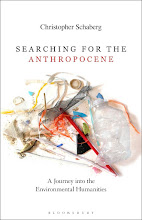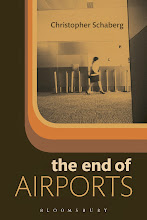Lopez introduces his book by placing the act of writing in the foreground, and thereby seeking to embed the reader in a detailed (if also entirely mediated) environment:
I am in a small cabin outside Fairbanks, Alaska, as I write these words. The cold sits down like iron here, and the long hours of winder darkness cause us to leave a light on most of the day. Outside, at thirty below, wood for the stove literally pops apart at the touch of the ax. I can see out across the short timber of the taiga when I am out there in the gray daylight. (1)
This is a prime example of what the literary scholar Timothy Morton calls “ecomimesis,” or when environmental writing attempts to “break the spell of language” and “go beyond the aesthetic dimension” (30–31). Lopez is calling on his readers to get into a scene—or as his next sentence puts it, “Go out there” (1). The ‘there’ in this sentence is both the Alaskan terrain and the inside of the book, a landscape of the mind. Lopez acknowledges a distance from his subject (he is writing here, not looking at wolves) precisely in order to achieve “a sense of the surrounding environment, not by being less artful, but more so” (Morton, 31). This is a common tactic throughout Of Wolves and Men, by which Lopez reminds his readers that, finally, the real environment of this text is not the behaviors and habitats of wolves, but rather the (un)knowing human mind in relation to all things wolves. As Lopez writes: “…in the wolf we have not so much an animal that we have always known as one that we have consistently imagined” (204).
Thus Lopez starts the first chapter with a visual directive to the reader: “Imagine a wolf moving though the northern woods…” (9). The following paragraph goes on to flesh out this imaginary scene, and the sentences are rife with figurative language: “The wolf’s body, from neck to hips, appears to float over the long, almost spindly legs and the flicker of wrists, a bicycling drift through the trees, reminiscent of the movement of water or of shadows” (9). The third paragraph, however, strikes a quite different note, scientific and declarative: “The wolf is three years old. A male. He is of the subspecies occidentalis, and the trees he is moving among are spruce and subalpine fir on the eastern slope of the Rockies in northern Canada (10). This type of stylistic shift is characteristic of how the environmental critic Lawrence Buell has described Lopez, as a “roaming” ethnographer, “gleaning insights more from interdisciplinary study and place-based informants…than from staying put” (69). Of Wolves and Men follows an indeterminate yet cumulative pattern of roaming between personal narratives, rumors, pictures, field accounts, and observations. This methodology allows Lopez to draw something of an open perimeter around his subject, which he defines as “a variable creature” (83).
The literary scholar Susan Kollin has shown how “…Lopez dismantles notions of Alaska as a pastoral or wilderness retreat, a place somehow cut off from the rest of the United States or the world” (46). So while certain passages from Of Wolves and Men linger on classic environmental imagery and specific ecosystems, the book continually shifts ground, requiring the reader to recalibrate and come to terms with outlying horizons of knowledge and experience. Indeed, Of Wolves and Men focuses on the lore and legends of wolves in order to expand a general sense of consciousness about how humans, in Lopez’s words, “…struggle to come to grips with the nature of the universe” (204). The scope of this book is at once narrowly focused on wolves, and almost endlessly expansive.
In one section Lopez explains a social phenomenon between wolves and ravens: ravens will often follow wolf tracks in order to discover (and clean up) fresh kills. In the next few paragraphs, Lopez follows this ecological dynamic into the realm of play, and relates stories of how ravens and wolves have been observed to tease one another and engage in games of tag, for fun (67–68). Such a move from scientific documentation to fanciful speculation is a signature feature of Lopez’s writing.
As Peter Wild writes in his book on Lopez, “Of Wolves and Men, founded on the premise that men have created varying concepts of wolves, tells perhaps more about the human psyche than it does about the physical wolf loping along in isolation through the centuries” (26). Of Wolves and Men appears to have a fairly traditional ‘environmental’ subject, yet there are ways in which this book can be understood to have anticipated contemporary intersections between critical theory and environmental studies, such as recent discussions of the human–animal conjunction (e.g. Agamben, Derrida, Haraway, & Wolfe). Near the end of the book, Lopez writes:
I think, as the twentieth century comes to a close, that we are coming to an understanding of animals different from the one that has guided us for the past three hundred years. We have begun to see again, as our primitive ancestors did, that animals are neither imperfect imitations of men nor machines that can be described entirely in terms of endocrine secretions and neural impulses. Like us, they are genetically variable, and both species and the individual are capable of unprecedented behavior. They are like us in the sense that we can figuratively talk of them as beings some of whose forms, movements, activities, and social organizations are analogous, but they are no more literally like us than are trees. (283–284)
This passage shows what the philosophical stakes are for Lopez in taking animality seriously as a subject of investigation; these sentences also demonstrate how, for Lopez, the wolf is both utterly unique and also a metonymy for life at large.
Of Wolves and Men is a hybrid manifesto on behalf of “human inquiry” and against “dogmatic certainty” (285), and its resistance to be strictly defined in terms of any one genre is in part what makes it such a significant environmental literary text. Barry Lopez’s work ranges across diverse subjects and fields of speculation, as one can tell from his more recent short story collections Field Notes and Light Action in the Caribbean. Of Wolves and Men offers an early indicator of how Lopez’s environmental sensibility functions as an elastic point of consciousness: it is both the space between humans and the world, and that which makes the two inseparable.
Bibliography
Agamben, Giorgio. The Open: Man & Animal. Stanford: Stanford UP, 2003.
Buell, Lawrence. The Future of Environmental Criticism: Environmental Crisis and Literary Imagination. Malden, MA: Blackwell, 2005.
Derrida, Jacques. The Animal That Therefore I Am. New York: Fordham UP, 2008.
Haraway, Donna. When Species Meet. Minneapolis: University of Minnesota Press, 2007.
Kollin, Susan. Nature’s State: Imagining Alaska as the Last Frontier. Chapel Hill: University of North Carolina Press, 2001.
Lopez, Barry. Of Wolves and Men. New York: Charles Scribner’s Sons, 1978.
Morton, Timothy. The Ecological Thought. Cambridge: Harvard UP, 2010.
Wild, Peter. Barry Lopez. Boise: Boise State University, 1984.
Wolfe, Cary. “Flesh and Finitude: Thinking Animals in (Post)Humanist Philosophy.” SubStance Issue 117 (Volume 37, Number 3), 2008.













